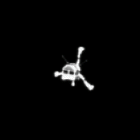 Launched in 2004, the European Space Agency’s Rosetta space probe, orbiting Comet 67P/Churyumov-Gerasimenko in the outer solar system, releases the Philae robotic lander to descend to 67P’s surface. The lander’s harpoon anchoring system doesn’t work entirely as expected, and Philae bounces off the surface and goes spaceborne again for two hours before coming to rest on the comet once more. Though Philae is able to gather scientific data and the first-ever pictures from a comet’s surface, the nearby geography prevents its solar panels from keeping its batteries at a full charge; ESA ground controllers are only able to intermittently contact Philae.
Launched in 2004, the European Space Agency’s Rosetta space probe, orbiting Comet 67P/Churyumov-Gerasimenko in the outer solar system, releases the Philae robotic lander to descend to 67P’s surface. The lander’s harpoon anchoring system doesn’t work entirely as expected, and Philae bounces off the surface and goes spaceborne again for two hours before coming to rest on the comet once more. Though Philae is able to gather scientific data and the first-ever pictures from a comet’s surface, the nearby geography prevents its solar panels from keeping its batteries at a full charge; ESA ground controllers are only able to intermittently contact Philae.
Tags:
Categories
Comments are closed